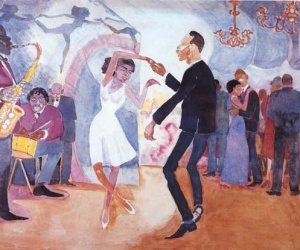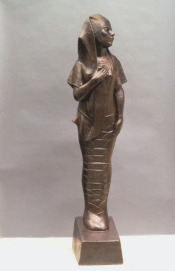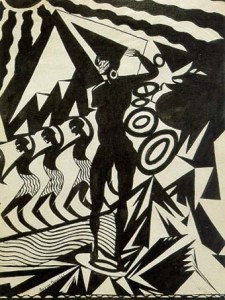Historical Materials
Meta Warrick Fuller’s sculpture Ethiopia Awakening was made in1910, foreshadowing the Harlem Renaissance. The sculpture depicts a graceful yet powerful African goddess, juxtaposing African culture and slavery. Fuller’s sculpture is just one example of the many Harlem Renaissance artists who looked toward their African heritage for inspiration.
 Palmer Hayden’s painting Jeunesse represents the modernity of the African American culture of the time. There’s a jazz band playing in the background with a couple dancing in the forefront and the light colors contribute to a lose atmosphere. The young couple’s dance style is in the forefront contrasting the dance styles of the older couples in the back.
Palmer Hayden’s painting Jeunesse represents the modernity of the African American culture of the time. There’s a jazz band playing in the background with a couple dancing in the forefront and the light colors contribute to a lose atmosphere. The young couple’s dance style is in the forefront contrasting the dance styles of the older couples in the back.
Aaron Douglas’ Sahdji (1925) is a fascinating drawing that combines modernist art themes with African cultural references. Douglas utilizes a unique drawing technique with ink and graphite on wove paper. The abstract drawing includes an African girl surrounded by various geometric shapes.
Annotated Sources
- Durkin, Hannah. “The Harlem Renaissance Revisited: Politics, Arts, And Letters.” Journal Of American Studies 46.3 (2012): N.PAG. Humanities International Complete. Web. 7 Nov. 2014. Hannah Durkin points out the struggle for black artists of the Harlem Renaissance to gain traction. Black artists came from different backgrounds and sought to achieve different goals with their art. Very few black artists were from Harlem and never even visited the borough despite representing the movement with their art. Black art intentions ranged from expressing the African lineage and heritage of the artists to showcasing black culture to a non-white audience. Black art gained a significant status in the 1920’s through a literary and networking center. Artists at the time were grouped with writers and musicians in order to gain traction.
- Calo, Mary Ann. “African American Art And Critical Discourse Between World Wars.” American Quarterly [51.3 (1999): 580. Humanities International Complete. Web. 7 Nov. 2014. Mary Ann Calo pays close attention to the black artists of the Harlem Renaissance. She explains how diverse art was during the era. Harlem Renaissance artists came from various backgrounds, had different inspirations, and their art was made for different audiences. Calo points out that in between world wars, black art included an emphasis on racial distinctiveness. The black community tackled ideas such as the interaction between race and nationality. As black art became more prevalent, the more criticism it received. Calo notes that black art was unfairly criticized as a form of marginalizing black artists. Black art could not rise to widespread acclaim as did other popular art of the time.
- Wright, George C. “Harlem Renaissance: Art Of Black America.” Journal Of American History 77.1 (1990): 251-261. Humanities International Complete. Web. 7 Nov. 2014.George C. Wright writes about the forgotten black artists of the Harlem Renaissance. The creative works of black authors and poets of the era tend to overshadow the works of black artists. Significant artists include Meta Warrick Fuller, Aaron Douglas, Palmer Hayden, William H. Johnson, and James Van Der Zee. Their work contains painting, photography, and sculpture. Black art reflected the culture of the time, dealing with racial discrimination and violence. Black artists also turned to their African heritage to look for inspiration. For example, Fuller is known for her Ethiopian Awakening sculpture. Carl Van Vechten, a white author and artist, documented the creative works of black artists through his photography. Wright emphasizes that black art should be held in a higher regard when the Harlem Renaissance is discussed.

